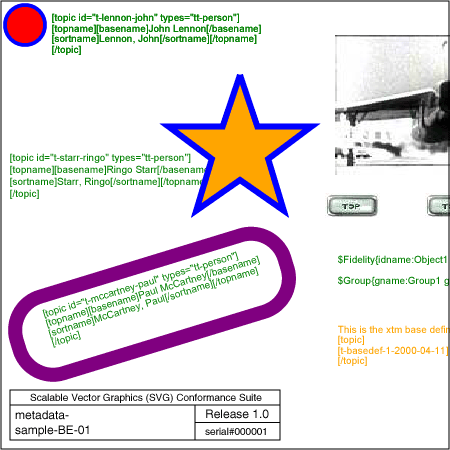

Verify the basic capability to handle properly formed (well-formed) metadata content in an SVG structure. Three graphical objects are drawn on the screen. Four images are placed on the screen. Text is placed on the screen. Each of the three drawn objects has text placed near the object. Two other clusterings of text are placed in remaining screen open space.
Three of the images are buttons (one plus half of another are clipped away). In BE-01 they initiate nothing when clicked. Dynamics may be in a future BE test (a BE-02?).
The test displays several drawings and images, statically, with text. The point of this test file is that the regular graphic and text functions in SVG operate as normal. There are no error messages or failures. The fact that this file has a huge amount of metadata in it and yet there were no problems displaying or executing it means that (properly formed) metadata content is both "transparent" and non-harmful. It is very notable that not only is there a large amount of metadata present in the file, that also there are two kinds of metadata simultaneously present! The two types of metadata present in the file are RDF and Topic Maps. They do not conflict with each other nor with SVG.
Each drawn object has metadata associated with it in the file. Some of that metadata is also displayed on the screen beside its object. Also of interest in this metadata test, is the use of metadata to capture or represent (author declared) fidelity information ($Fidelity) which permits authors a means of declaring their ("output") intention. After a styling event, say, this fidelity information can be used to recover the author's intended output. The fidelity is signed. The metadata in this file ($Group) also captures author declared logical grouping independent of <g> and <svg>. Some mathml is also (gratuitously) present in the RDF as namespace test.
The rendered picture should match the reference image, except for possible variations in the labelling text (per CSS2 rules).
The test uses significant graphical functionality, including the 'rect' and 'polygon' elements, imported images, clipping control, and numerous properties such as basic solid fill, stroke (colored and wide lines), font-family (Helvetica and Arial) and font-size properties.